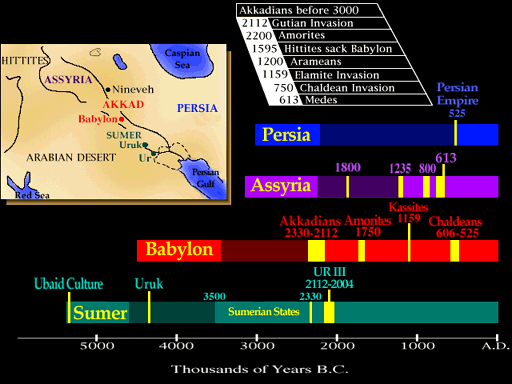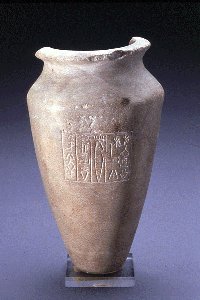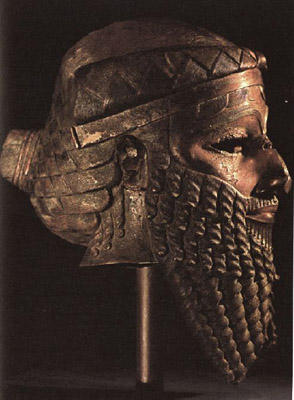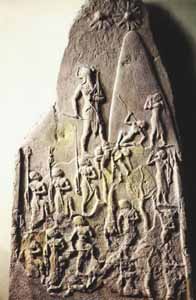



Akkad (or Agade) was a city and its region of northern Mesopotamia, situated on the left bank of the Euphrates, between Sippar and Kish (located in present-day Iraq, ca. 50 km south-west of the center of Baghdad, 33.1° N 44.1° E). It reached the height of its power between the 22nd and 18th centuries BCE, before the rise of Babylonia. Akkad gave its name to the Akkadian language, reflecting use of akkadű ("in the language of Akkad") in the Old Babylonian period to denote the Semitic version of a Sumerian text.
The Sumerians and the Akkadian cultures formed the principle elements in the population of Mesopotamia before the beginning of recorded history and in the millennium thereafter (the 3rd millennium BCE - c.2350-2200 BCE). They lived hormoniously in a period that appeared to be predominately free of strong racial ideologies or ethnic stereotypes.
Akkadians were semi-nomads at a time when many people roamed from place to place depedning on the seasons. Semi-nomads graze their small live stock near the fields of their settlements, often trading for goods obtained elsewhere.
�A�k�k�a�d�i�a�n� �w�a�s� �a� �S�e�m�i�t�i�c� �l�a�n�g�u�a�g�e� �(�p�a�r�t� �o�f� �t�h�e� �g�r�e�a�t�e�r� �A�f�r�o�-�A�s�i�a�t�i�c� �l�a�n�g�u�a�g�e� �f�a�m�i�l�y�)� �s�p�o�k�e�n� �i�n� �a�n�c�i�e�n�t� �M�e�s�o�p�o�t�a�m�i�a�,� �p�a�r�t�i�c�u�l�a�r�l�y� �b�y� �t�h�e� �A�s�s�y�r�i�a�n�s� �a�n�d� �B�a�b�y�l�o�n�i�a�n�s�.� �I�t� �u�s�e�d� �t�h�e� �c�u�n�e�i�f�o�r�m� �w�r�i�t�i�n�g� �s�y�s�t�e�m� �d�e�r�i�v�e�d� �u�l�t�i�m�a�t�e�l�y� �f�r�o�m� �a�n�c�i�e�n�t� �S�u�m�e�r�i�a�n�,� �a�n� �u�n�r�e�l�a�t�e�d�,� �n�o�n�-�S�e�m�i�t�i�c� �l�a�n�g�u�a�g�e�.� �T�h�e� �n�a�m�e� �o�f� �t�h�e� �l�a�n�g�u�a�g�e� �i�s� �d�e�r�i�v�e�d� �f�r�o�m� �t�h�e� �c�i�t�y� �o�f� �A�k�k�a�d�,� �a� �m�a�j�o�r� �c�e�n�t�e�r� �o�f� �M�e�s�o�p�o�t�a�m�i�a�n� �c�i�v�i�l�i�z�a�t�i�o�n�.
Dialects
Akkadian is divided into dialects based on geography and historical period:
Clay Tablets - Cuneform
Akkadian scribes wrote the language using cuneiform script, an earlier writing system devised by the Sumerians using wedge-shaped signs pressed in wet clay that in Akkadian could represent either (a) Sumerian logograms (i.e. picture-based characters as in Chinese), (b) Sumerian syllables, (c) Akkadian syllables, and (d) phonetic complements. Cuneiform was in many ways unsuited to Akkadian: among its flaws was its inability to represent important phonemes in Semitic, including a glottal stop, pharyngeals, and emphatic consonants. In addition, cuneiform was a syllabary writing system - i.e. a consonant plus vowel comprised one writing unit - frequently inappropriate for a Semitic language made up of triconsonantal roots (i.e. three consonants minus any vowels). Older Sumerian cuneiform also distinguished between the vowels i and e; this distinction, though not originally present in Akkadian, was adopted by scribes to compensate for the disappearance (or non-writing) of the original Semitic pharyngeals.
Akkadian grammar
Akkadian is an inflected language, and as a Semitic language its grammatical features are highly similar to those found in Classical Arabic. It possesses two genders (masculine and feminine), distinguished even in second person pronouns (you-masc., you-fem.) and verb conjugations; three cases for nouns and adjectives (nominative, accusative, and genitive); three numbers (singular, dual, and plural); and unique verb conjugations for each first, second, and third person pronoun.
Akkadian nouns are declined according to gender, number and case. There are three genders; masculine, feminine and common. Only a very few nouns belong to the common gender. There are also three cases (nominative, accusative and genitive) and three numbers (singular, dual and plural). Adjectives are declined exactly like nouns.
Akkadian nouns are declined according to gender, number and case. There are three genders; masculine, feminine and common. Only a very few nouns belong to the common gender. There are also three cases (nominative, accusative and genitive) and three numbers (singular, dual and plural). Adjectives are declined exactly like nouns.
The remaining root stems are all derived from the first eight and are very similar in meaning. Akkadian verbs usually display the tri-consonantal root, though some roots with two- or four-consonant roots also exist. These are called radicals. There are three tenses, present, preterite and permansive. Present tense indicates incomplete action and preterite tense indicates complete action, while permansive tense expresses a state or condition and usually takes a particle.
Akkadian, unlike Arabic, has mainly regular plurals (i.e. no broken plurals), although some masculine words take feminine plurals. In that respect, it is similar to Hebrew.
Word Order
Akkadian sentence order was subject + object + verb (SOV), which sets it apart from most other Semitic languages such as Arabic and Hebrew, which typically have a verb + subject + object (VSO) word order. (South Semitic languages in Ethiopia are another matter altogether.) It has been hypothesized that this word order was a result of influence from the Sumerian language, which was also SOV. There is evidence that native speakers of both languages were in intimate language contact, forming a single society for at least 500 years, so it is entirely likely that a sprachbund could have formed. Further evidence of an original VSO or SVO ordering can be found in the fact that direct and indirect object pronouns are suffixed to the verb. Word order seems to have shifted to SVO/VSO late in the 1st millennium BC to the 1st millennium AD, possibly under the influence of Aramaic.
Akkadian literature
Among the works written in Akkadian cuneiform are the Epic of Gilgamesh and the Atrahasis Epic. The Atrahasis Epic was a story writted in the early 2nd millennium B.C. in Akkadian. It is a cosmological epic that depicts the creation and early human history, including a flood. Its hero is Atrahasis. The flood account in tablet III of the Atrahasis Epic has much resemblance to that contained in the Gilgamesh Epic.
Reference: Mercer, Samuel A B (1961) Introductory Assyrian Grammar


Akkadian period, reign of Naram-Sin


ALPHABETICAL INDEX OF ALL FILES